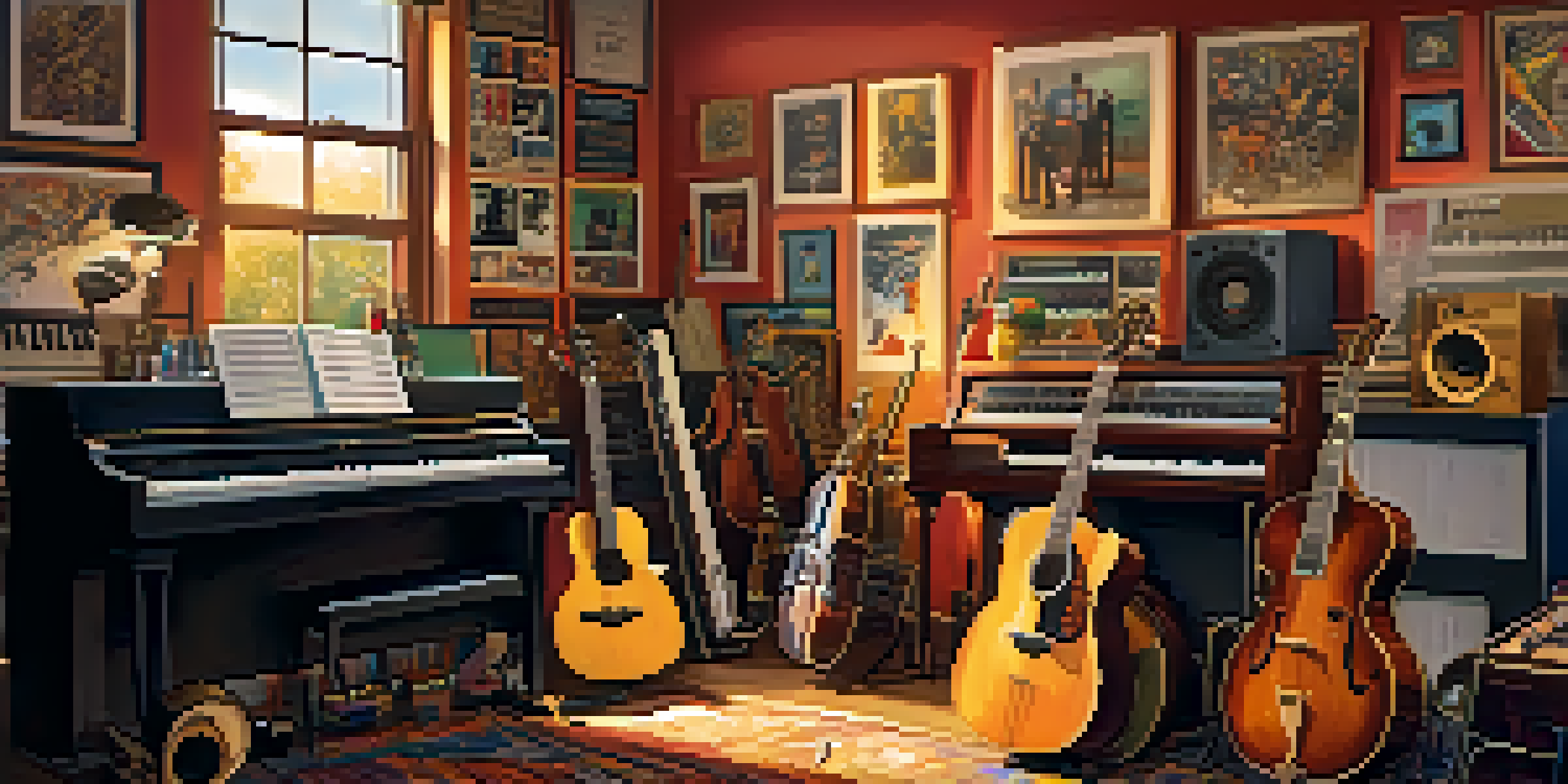The Creative Process: How Musicians Collaborate Effectively

Understanding the Importance of Collaboration in Music
Collaboration is at the heart of many musical creations, as it brings together diverse perspectives and skills. When musicians work together, they can combine their individual strengths, leading to richer and more innovative soundscapes. This synergy often results in music that resonates more deeply with audiences, as it reflects a blend of ideas and emotions.
The only way to do great work is to love what you do.
Consider famous bands like The Beatles, whose unique collaboration produced timeless hits. Each member contributed their distinct musical styles and ideas, creating a harmonious blend that shaped modern music. This example illustrates how collaboration can elevate a project beyond what individual artists might achieve alone.
Ultimately, effective collaboration fosters an environment of creativity where musicians feel free to express themselves. It encourages experimentation and can lead to unexpected breakthroughs, making the process not only productive but also incredibly rewarding.
Creating a Collaborative Environment for Musicians
Establishing a nurturing space for collaboration is essential for any successful musical partnership. This environment should promote open communication, allowing musicians to share their ideas without fear of judgment. A comfortable atmosphere can lead to honest discussions and more authentic musical expressions.

For instance, many artists prefer informal jam sessions to brainstorm and develop new material. These low-pressure settings allow for spontaneity, resulting in creative sparks that structured environments might stifle. By prioritizing comfort, musicians can tap into their collective creativity more effectively.
Collaboration Enhances Creativity
Working together allows musicians to blend their strengths, resulting in innovative and resonant music.
Additionally, fostering a culture of respect and appreciation among collaborators is crucial. When musicians value each other's contributions, it builds trust, making it easier to take risks and explore new ideas together.
Effective Communication: The Key to Musical Collaboration
Communication is the backbone of any successful collaboration, especially in music. Musicians need to express their thoughts, feelings, and ideas clearly to ensure everyone is on the same page. This clarity helps prevent misunderstandings and keeps the creative process flowing smoothly.
Alone we can do so little; together we can do so much.
Consider how a simple miscommunication about a song's tempo can lead to frustration during recording sessions. By discussing preferences and expectations upfront, musicians can avoid unnecessary conflicts and maintain a productive atmosphere. It's all about being open and receptive to feedback and suggestions.
Moreover, using tools like digital collaboration platforms can enhance communication, especially when working with remote collaborators. These platforms allow musicians to share ideas, recordings, and feedback in real time, bridging the gap created by distance and ensuring that everyone stays in sync.
Balancing Individuality and Collaboration in Music
While collaboration is essential, maintaining individual artistic identity is equally important. Musicians should strive to bring their unique styles and influences into the collaborative process. This balance can produce music that is both personal and collectively enriching.
Take, for example, the collaboration between Beyoncé and Jack White on 'Don't Hurt Yourself.' Each artist's distinct sound and persona shine through, creating a powerful track that showcases their individuality while reinforcing their combined strength. This dynamic can lead to innovative sounds that might not emerge in solo projects.
Effective Communication is Crucial
Clear communication among musicians prevents misunderstandings and keeps the creative process flowing smoothly.
Encouraging each musician to express their individuality ensures that the collaboration remains fresh and exciting. It also allows for a more diverse exploration of ideas, blending various genres and styles that can surprise both the creators and their audience.
Setting Clear Goals for Collaborative Projects
Having clear goals is vital for successful collaboration in music. Before diving into a project, collaborating musicians should discuss their objectives and expectations. This alignment helps ensure that everyone is working towards a common vision, making the creative process more efficient.
For example, if a group is aiming to produce an album, it's essential to discuss the desired sound, themes, and timelines. By establishing these parameters, musicians can streamline their efforts and focus on what truly matters. This clarity reduces the chances of going off track and losing sight of the project’s purpose.
Moreover, revisiting these goals throughout the collaboration can keep everyone motivated and accountable. As the project evolves, it’s important to assess whether the initial goals are still relevant and make adjustments as needed.
Embracing Flexibility in the Collaborative Process
Flexibility is crucial in the creative process, as it allows musicians to adapt and evolve their ideas. Sometimes, the best outcomes arise from unexpected changes or detours in the collaboration. By embracing a flexible approach, musicians can explore new directions that they might not have considered initially.
For instance, during the recording of an album, an artist might experiment with a different genre or style that emerges organically from a jam session. This openness can lead to innovative tracks that surprise both the musicians and their audience. Flexibility encourages creativity and can lead to unique musical expressions.
Flexibility Fuels Musical Innovation
Embracing flexibility in the collaborative process allows musicians to explore new ideas and directions.
However, flexibility doesn’t mean sacrificing structure. Finding a balance between adaptability and direction can help musicians maintain momentum while still allowing for creative exploration.
Learning from Each Collaboration Experience
Every collaboration offers valuable lessons that can enhance a musician's future projects. Reflecting on what worked well and what didn’t helps artists grow and refine their collaborative skills. This continuous learning process is essential for evolving as a musician.
After completing a project, musicians can take time to discuss their experiences and share feedback. This reflection can reveal insights into their collaborative dynamics, enabling them to identify strengths and areas for improvement. By being open to feedback, musicians can enhance their future collaborations.

Moreover, celebrating successes, regardless of size, is vital for maintaining motivation. Recognizing achievements fosters a positive collaborative spirit, encouraging musicians to continue exploring new partnerships and creative ventures.